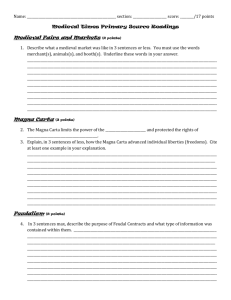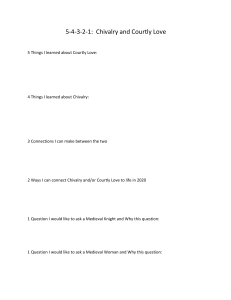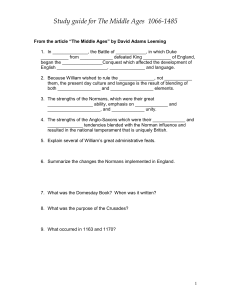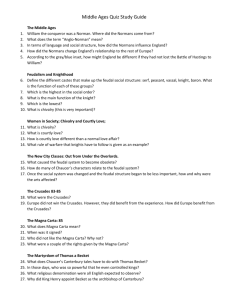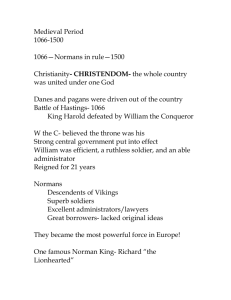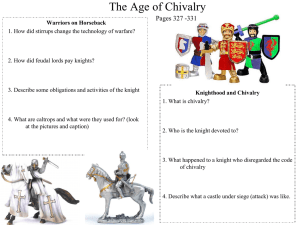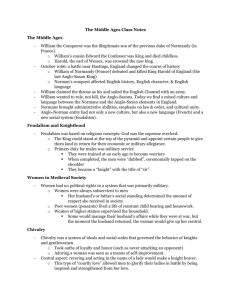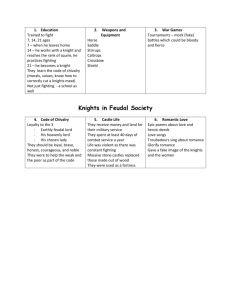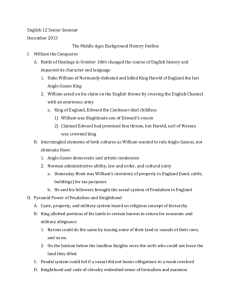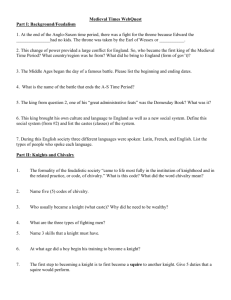Middle Ages Outline: 1066-1485
advertisement
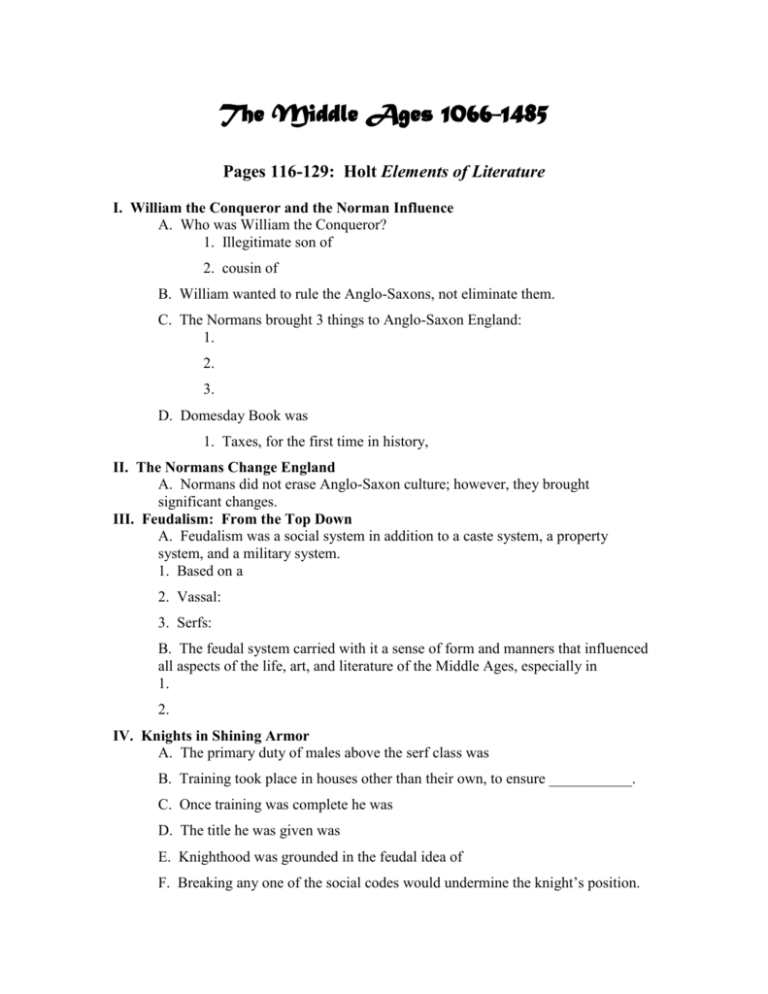
The Middle Ages 1066-1485 Pages 116-129: Holt Elements of Literature I. William the Conqueror and the Norman Influence A. Who was William the Conqueror? 1. Illegitimate son of 2. cousin of B. William wanted to rule the Anglo-Saxons, not eliminate them. C. The Normans brought 3 things to Anglo-Saxon England: 1. 2. 3. D. Domesday Book was 1. Taxes, for the first time in history, II. The Normans Change England A. Normans did not erase Anglo-Saxon culture; however, they brought significant changes. III. Feudalism: From the Top Down A. Feudalism was a social system in addition to a caste system, a property system, and a military system. 1. Based on a 2. Vassal: 3. Serfs: B. The feudal system carried with it a sense of form and manners that influenced all aspects of the life, art, and literature of the Middle Ages, especially in 1. 2. IV. Knights in Shining Armor A. The primary duty of males above the serf class was B. Training took place in houses other than their own, to ensure ___________. C. Once training was complete he was D. The title he was given was E. Knighthood was grounded in the feudal idea of F. Breaking any one of the social codes would undermine the knight’s position. V. Women in Medieval Society: No Voice, No Choice A. Women had no rights and were always __________________. VI. Chivalry and Courtly Love: Ideal but Unreal A. Chivalry: a system of 1. Taking the oath of loyalty to the overlord 2. Observing certain rules of warfare a. never attacking an ___________________________________ 3. Adoring a lady was a means of _______________________________. B. Courtly Love: the idea that adoring a ________ would make a knight braver and nobler. C. A knight might wear D. The lady always remained pure and E. The lady was set above her admirer just as the feudal F. If the line was crossed, the sexual code was broken, the entire social system would collapse. 1. Arthur’s Round Table 2. Sir ____________________ and Queen ___________________ G. _______________________ crumbles because the sexual code was broken. VII. The Rise of Romance A. A woman’s perceived value remained B. Chivalry gave rise to a new form of literature: 1. Greatest example: 2. Modern example: VIII. The New City Classes: Out from Under the Overlords A. Medieval society centered on B. As the population grew, more people lived in C. City classes 1. 2. 3. D. Many of Chaucer’s characters make their living __________________ the feudal system. E. The ________________ class had its own tastes and the ability to pay for them. F. The people of the ____________ were free, tied to neither ___________ nor to knighthood and chivalry. G. Ballads (see pg. 130): IX. The Great Happenings A. The Crusades: Bloodbath over the Holy Land 1. Crusades (1095-1270): 2. Pope Urban II told Christians to wage war against 3. Europe benefited greatly from its contact with the Middle Easterners: a. Mathematics b. c. d. crafts B. The Martyrdom of Thomas a Becket: Murder in the Cathedral 1. The goal of Chaucer’s pilgrims was 2. Thomas, a Norman, was a powerful chancellor (prime minister). 3. Kings were ____________ of the Pope (God’s representative). 4. King Henry appointed Thomas to be ___________________________, hoping to gain the upper hand in disputes with the Church. 5. Thomas took ______________ side once too often and 4 of Henry’s knights murdered Thomas in his own cathedral. 6. The medieval Church had one positive effect: 7. The Church continued to be the C. The Magna Carta: Power to (Some of) the People 1. The signing of the Magna Carta by ____________ in 1215, heralded a return to more democratic tendencies in England. 2. The aristocrats never had interest in the common people. 3. The Magna Carta later became the basis of English constitutional law, in which such rights as __________________ and _________________ were established. D. The Hundred Years’ War (1337-1453): The Arrow is Mightier Than the Armor 1. The Hundred Years’ War was fought on the Continent and was based on weak claims to the throne of France by _____________________ and _____________________, two English kings. 2. After the war, the English were not longer best represented by 3. They were more accurately represented by the green-clad yeoman with his long bow. 4. These small landowners called __________________ now became a dominant force. E. The Black Death or bubonic plague (1348-1349) 1. The disease spread by 2. It reduced the nations population by 3. This caused a labor shortage and gave power to the _______________. 4. A long-term result: 5. Henry VII began the Tutor line that would lead to ________________.

